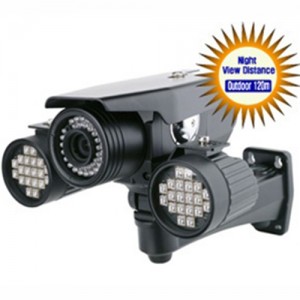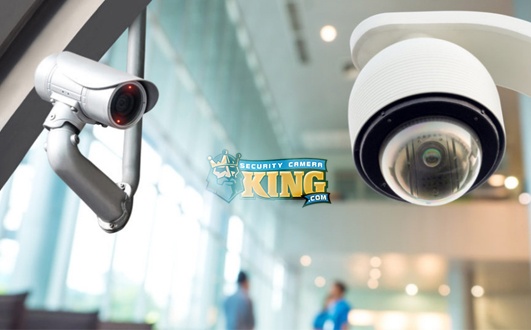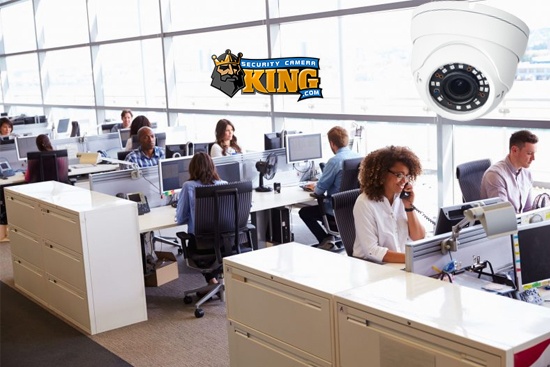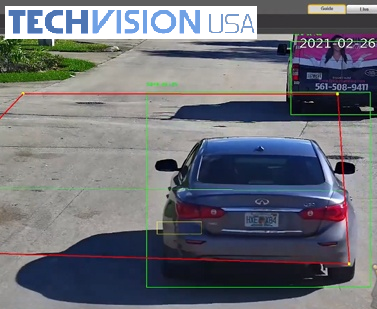 Infrared Surveillance Cameras or Day/Night Cameras are becoming very popular as business and home security cameras. They provide a full color picture in daytime or adequate light situations. Gradually switching to BW at night or low light to maintain picture quality, Infrared cameras, as their name suggests, contain an array of Infrared LED’s that turn on in low light and can provide a B/W picture in complete darkness.
Infrared Surveillance Cameras or Day/Night Cameras are becoming very popular as business and home security cameras. They provide a full color picture in daytime or adequate light situations. Gradually switching to BW at night or low light to maintain picture quality, Infrared cameras, as their name suggests, contain an array of Infrared LED’s that turn on in low light and can provide a B/W picture in complete darkness.
Security Camera King’s infrared cameras are equipped with IR illuminators that can allow the infrared surveillance camera to “see” in complete darkness, and provide superb video performance in the worst lighting conditions. An infrared surveillance camera is perfect for night applications or for applications with poor lighting conditions. Infrared security surveillance cameras use infrared radiation known as “near infrared” light that is invisible to the human eye. Many of our IR cameras feature infrared illumination using photocell activation, which automatically switches on and off the camera’s illuminators as lighting conditions change.
An infrared surveillance camera is any camera that is design with Infrared light built in with illuminators for day and night time video surveillance. All infrared cameras come with a light sensor built in to switch the IR on when light conditions go below 1LUX rating. All infrared color cameras will change to Black and White when IR sensor is on. Infrared security surveillance cameras are very popular and can be used anywhere.
An infrared surveillance camera has infrared LED lighting (light from a different region of the electromagnetic spectrum than we normally cannot see) installed around the outside of the lens of the camera. This lighting allows the camera to capture a good image in no light at all. With a little bit of light (called low light) the infrared camera can capture a picture that looks just like daytime. People use infrared security cameras for businesses that have the lights out at night (in case of break-ins). Or for outside, nighttime viewing. Keep in mind that even at nighttime there is a normally some light from the moon, stars, or street lights.
Infrared cameras are often called “Night Vision” cameras because they can ‘see’ at night. However, do not confuse “Night Vision” with “Day / Night Cameras”. Day / Night cameras do not have infrared lights built in.
Infrared surveillance cameras will provide a color picture while the light is good. When it gets dark, the camera will switch to infrared mode and illuminate the field of vision using its built-in infrared LEDs. In infrared mode the image is captured in black and white – this is true of all infrared cameras because infrared light is out of the visible light spectrum.. The level of light required to capture a good picture is referred to as a camera’s lux, the lower the lux the better the camera can see in low light. For example a camera with 0.003 lux is better than a camera with 0.2 lux. Infrared cameras are considered to be 0.0 lux in infrared mode – in other words they can ‘see’ with no light at all.
Infrared cameras are also compared by how far they can see in total darkness. This is generally a result of how many infrared LEDs are built into the camera. Many cameras can see on the average between 50 and 150 feet although some cameras can see as far as 300 feet with no light at all! This can be extended even further by using illuminators, infrared LED light bars that can extend your range.
If you are going to use an infrared camera outdoors, it’s best to use an outdoor weatherproof bullet style camera. This is because if you use an indoor infrared camera and need to put it in an outdoor housing, sometimes the infrared light reflects off the glass of the housing. Some people get acceptable results if the camera is absolutely flush up to the glass thereby reducing the glare. This works well for example if there are street lights outside or an exterior light that can be left on at night. Keep in mind that cameras without infrared lighting will not capture an image with zero light. The other issue to consider is that infrared cameras require more power (usually more amperage). The power requirements are provided in the specs for each camera.
If you need more information about infrared surveillance cameras, please don’t hesitate to contact one of Security Camera King’s security experts. We’ll be glad to help!












